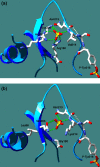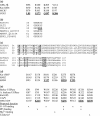In silico evidence for functional specialization after genome duplication in yeast
- PMID: 19133069
- PMCID: PMC2704937
- DOI: 10.1111/j.1567-1364.2008.00451.x
In silico evidence for functional specialization after genome duplication in yeast
Abstract
A fairly recent whole-genome duplication (WGD) event in yeast enables the effects of gene duplication and subsequent functional divergence to be characterized. We examined 15 ohnolog pairs (i.e. paralogs from a WGD) out of c. 500 Saccharomyces cerevisiae ohnolog pairs that have persisted over an estimated 100 million years of evolution. These 15 pairs were chosen for their high levels of asymmetry, i.e. within the pair, one ohnolog had evolved much faster than the other. Sequence comparisons of the 15 pairs revealed that the faster evolving duplicated genes typically appear to have experienced partially--but not fully--relaxed negative selection as evidenced by an average nonsynonymous/synonymous substitution ratio (dN/dS(avg)=0.44) that is higher than the slow-evolving genes' ratio (dN/dS(avg)=0.14) but still <1. Increased number of insertions and deletions in the fast-evolving genes also indicated loosened structural constraints. Sequence and structural comparisons indicated that a subset of these pairs had significant differences in their catalytically important residues and active or cofactor-binding sites. A literature survey revealed that several of the fast-evolving genes have gained a specialized function. Our results indicate that subfunctionalization and even neofunctionalization has occurred along with degenerative evolution, in which unneeded functions were destroyed by mutations.
Figures




Similar articles
-
Consistent patterns of rate asymmetry and gene loss indicate widespread neofunctionalization of yeast genes after whole-genome duplication.Genetics. 2007 Mar;175(3):1341-50. doi: 10.1534/genetics.106.066951. Epub 2006 Dec 28. Genetics. 2007. PMID: 17194778 Free PMC article.
-
Parallel Nonfunctionalization of CK1δ/ε Kinase Ohnologs Following a Whole-Genome Duplication Event.Mol Biol Evol. 2023 Dec 1;40(12):msad246. doi: 10.1093/molbev/msad246. Mol Biol Evol. 2023. PMID: 37979156 Free PMC article.
-
Identity and divergence of protein domain architectures after the yeast whole-genome duplication event.Mol Biosyst. 2010 Nov;6(11):2305-15. doi: 10.1039/c003507f. Epub 2010 Aug 26. Mol Biosyst. 2010. PMID: 20820472
-
Retention of protein complex membership by ancient duplicated gene products in budding yeast.Trends Genet. 2007 Jun;23(6):266-9. doi: 10.1016/j.tig.2007.03.012. Epub 2007 Apr 10. Trends Genet. 2007. PMID: 17428571 Review.
-
Whole-Genome Duplication and Yeast's Fruitful Way of Life.Trends Genet. 2019 Jan;35(1):42-54. doi: 10.1016/j.tig.2018.09.008. Epub 2018 Oct 23. Trends Genet. 2019. PMID: 30366621 Review.
Cited by
-
A haploproficient interaction of the transaldolase paralogue NQM1 with the transcription factor VHR1 affects stationary phase survival and oxidative stress resistance.BMC Genet. 2015 Feb 11;16:13. doi: 10.1186/s12863-015-0171-6. BMC Genet. 2015. PMID: 25887987 Free PMC article.
-
Expression and evolution of the non-canonically translated yeast mitochondrial acetyl-CoA carboxylase Hfa1p.PLoS One. 2014 Dec 11;9(12):e114738. doi: 10.1371/journal.pone.0114738. eCollection 2014. PLoS One. 2014. PMID: 25503745 Free PMC article.
-
Evolution of a Yeast With Industrial Background Under Winemaking Conditions Leads to Diploidization and Chromosomal Copy Number Variation.Front Microbiol. 2018 Aug 3;9:1816. doi: 10.3389/fmicb.2018.01816. eCollection 2018. Front Microbiol. 2018. PMID: 30127779 Free PMC article.
-
Whole genome resequencing and comparative genome analysis of three Puccinia striiformis f. sp. tritici pathotypes prevalent in India.PLoS One. 2022 Nov 3;17(11):e0261697. doi: 10.1371/journal.pone.0261697. eCollection 2022. PLoS One. 2022. PMID: 36327308 Free PMC article.
-
Salmo salar and Esox lucius full-length cDNA sequences reveal changes in evolutionary pressures on a post-tetraploidization genome.BMC Genomics. 2010 Apr 30;11:279. doi: 10.1186/1471-2164-11-279. BMC Genomics. 2010. PMID: 20433749 Free PMC article.
References
-
- Bax B, Carter PS, Lewis C, et al. The structure of phosphorylated GSK-3beta complexed with a peptide, FRATtide, that inhibits beta-catenin phosphorylation. Structure. 2001;9:1143–1152. - PubMed
-
- Belli G, Molina MM, Garcia-Martinez J, Perez-Ortin JE, Herrero E. Saccharomyces cerevisiae glutaredoxin 5-deficient cells subjected to continuous oxidizing conditions are affected in the expression of specific sets of genes. J Biol Chem. 2004;279:12386–12395. - PubMed
-
- Bisaillon M, Shuman S. Structure-function analysis of the active site tunnel of yeast RNA triphosphatase. J Biol Chem. 2001;276:17261–17266. - PubMed
MeSH terms
Substances
LinkOut - more resources
Full Text Sources
Molecular Biology Databases

